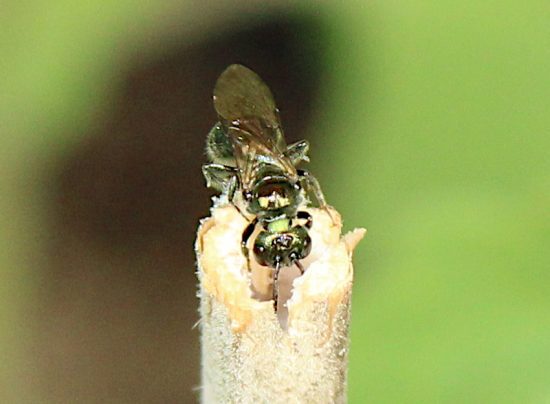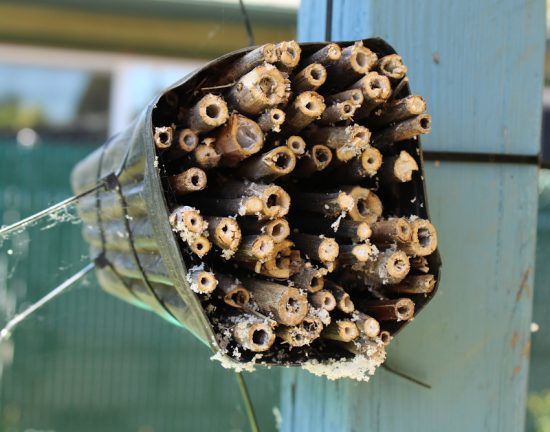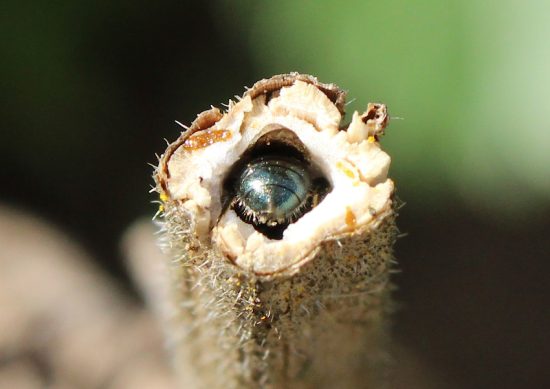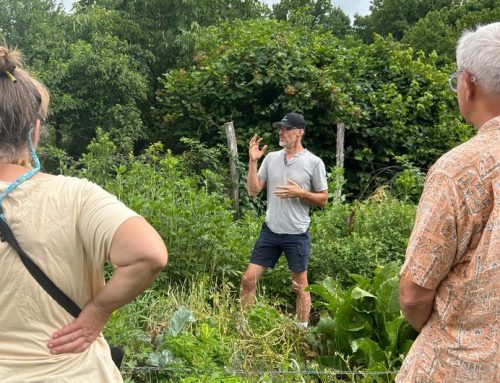When I wrote that I was confused by conflicting info online about stem-besting bees and how gardeners can help them, Amy Campion left an instructive comment and offered to guest-post about it for our readers. Naturally I jumped on her offer and the result is this terrific report, based on years of doing and observing in an actual garden! Susan
You want to do the right thing.
You know whacking perennials to the ground can harm bees and other beneficial insects overwintering inside the stems. You want to do better. So, you do your research, but all you can find on bee-safe pruning is vague and contradictory advice. Why is it so complicated?
Actually, pruning perennials while protecting bees is simple, if you take a little time to understand who’s living in your stems.

You can help stem-nesting bees thrive in your garden.
I’ve been gardening for 28 years, and for the past three years, I’ve been obsessed with gardening for bees and other insects. I’ve been renovating my garden and my gardening practices for them. Now, my garden hosts countless native bees, including hundreds of stem-nesting bees. Here’s what you need to know to help these precious pollinators thrive in your garden.
Insects are overwintering in your stems—or are they?
Most gardeners know it’s best to leave perennials standing all winter for wildlife, but when it comes time to cut the tired plants down, they hesitate. They believe all kinds of beneficial bugs are overwintering in those stems.
That’s a myth.
In reality, very few insects are able to bore into an intact stem, and the few that do are generally considered pests. Most insects that nest in stems need an access point—the stem has to be cut or broken so they can get inside.
The life and times of Ceratina bees
In my experience (in Portland, Oregon), the vast majority of insects that nest in cut stems are small carpenter bees in the genus Ceratina. These tiny, shiny black bees look like flying ants. They’re gentle, nonaggressive bees, and they’re terrific pollinators. They visit many different flowers in the garden—they’re not picky eaters.
Most small carpenter bees lead solitary lives. Each female mates and then looks for a cut stem to nest in. She’ll chew into the pithy center and make her nest cells inside. She lines up the nursery cells like the rooms in a shotgun house, using chewed-up pith to make the cell walls.

A small carpenter bee checks out an agastache stem I’ve cut long.
In each cell she puts a ball of pollen mixed with a little nectar, and then she lays a single egg on each pollen ball. The egg hatches, and the grublike baby bee eats the pollen. It spins a cocoon and becomes a pupa, and eventually, an adult bee. In some species, this process takes an entire year. Other species may produce two or three generations per year.
When and how to prune your perennials
Small carpenter bees are some of the first native bees to emerge in the spring. Here in western Oregon, they typically come out during the first warm, sunny days of March. I start cutting my perennials back in late February, so there will be fresh nesting opportunities ready for them. They’re active all season here—from March through September.
When I cut my perennials back, I leave about 12 inches of dead stem standing. After the initial cut, I don’t cut them again. A female will sometimes reuse her childhood home for her own offspring, and a stem may be in continuous use for multiple years. I don’t want to disturb the inhabitants.

Cut your perennials long for small carpenter bees.
Eventually, the stem will break down and fall out of use, and that’s a good thing. Pests and diseases can build up in old, funky stems.
Which plants are best?
Only plants with the sturdiest stems get this treatment, because they’ll be occupied for at least a year, and they’ll have to hold up. Short, wiry, or floppy plants don’t make good bee habitat. They get cut to the ground.
In my garden, Ceratina bees prefer strong, pithy plant stems like raspberry, Douglas aster, goldenrod (especially ‘Fireworks’), and perennial sunflower (‘Lemon Queen’). They also use some plants with hollow stems, such as wild bergamot (Monarda fistulosa), tall agastaches, and Verbena hastata. They use milkweeds, too, but the stems don’t seem to hold up long-term. Try different plants and see what they like in your garden.
Going sideways
Stems can be oriented vertically or horizontally. In fact, my first small carpenter bee habitat came about by accident when I stacked a pile of sticks in a sunny spot by the house for kindling. We quit using the fireplace, and in the meantime, bees moved into the sticks en masse.
I’ve also made small carpenter bee hotels out of bundles of cut raspberry canes. I hung them under our patio awning. The bees loved them, but when some teeny, tiny parasitoid wasps that target Ceratina bees found my hotels, I realized mass housing units are a bad idea. They make the bees more vulnerable to attack.

Small carpenter bee hotels are not a great idea.
Now, I make sure to scatter housing opportunities all over my garden. In addition to cutting my strongest perennials long, I stick extra raspberry cane trimming right into the ground (I make sure they’re dead, so they don’t root in), and I also attach some to my fence.
The tradeoff
You may not like the look of long, dead stems in your garden—I get that—but they’ll be covered up by new growth in no time. If you’re still reluctant to leave dead, twiggy growth in your garden for even a little while, let me encourage you to create one small patch and then watch. Once you notice these charming pollinators making homes in the habitat you’ve provided, you’ll look at those stems differently.
How will you know when the bees are using your stems? Look for round holes in the cut ends where the mothers have chewed their way in. Plus, you’ll see the bees! You’ll see males patrolling the area for mates, and you’ll see females provisioning their cells.
You’ll also probably see shiny butts visible at the ends of the stems.

Bee butts!
Small carpenter bee moms stay with their offspring and watch over them as they mature, which is unusual among solitary bees. It warms my heart to see these little bee butts and know I’m helping these wonderful creatures thrive.





Amy, Thank You! That was a nice, well-written, informative article!
I appreciated the information sans the media’s normal click-bait shaming and exhortation that we should replace our lawns with sturdy stubble stems. Who knew there was room in our gardens for both, critters and our aesthetic references?
Thanks, John! I have more to say on this general topic, and I know I have to choose my words carefully or people will be turned off. I try to focus on the positive and all the new things you get to see if you provide some habitat for wildlife in your garden.
Lovely and informative article, Amy, thanks!
Leaving little undisturbed areas on the margins sounds like a good idea for all of us.
Maybe I’ll write about that in a future article.
Thank-you Amy. An excellent article on how to prune thoughtfully. I always vacillate about cleanup in the Spring. If I leave everything standing then I don’t get to enjoy all the bulbs that are planted throughout.
Glad you found it helpful! If you’re a little bit strategic about it, bulbs and nesting habitat can definitely coexist.
Amy, great article. Well written. Now I have to encourage my wife to listen, and read.
She learned from her English mother that everything in the garden was cut back to the ground in the Fall. I am making progress.
We miss you in Cincinnati!!
Hi Kevin, It is a shift in thinking about the garden that doesn’t happen overnight. Maybe if she sees some bee butts, she’ll change her mind. I miss all you Tree Geeks, too! I really enjoyed my years in Cincinnati.
Amy (and all),
There is no such thing as “aesthetic references” which appeared at the end of my original comment. The “P” key on my laptop keeps sticking. As a reult, I have trouble “P”ing. Older males like me often have that problem. Da Missus, without a prostate which gets congested from time to time, does not seem to have this problem.
John
Lol, I thought it was a term I wasn’t familiar with, but I got the gist of what you were saying.
Hi Amy: I did not previously know about the bee-stem relationship, so thanks for that information. I read some time ago that bee populations are bouncing back across the nation, are you seeing any evidence of that?
John
What you probably read was about honey bees. Honey bees have a lot of problems, but ultimately they will be fine. They are non-native livestock in our country. They’re mostly used to pollinate almond trees, and the almond farmers won’t let them fail. There’s too much money at stake.
What you don’t read about is the fact that the U.S. has 4000 other native bees that are just as important. We don’t know as much about them, because we have just started doing research on them, but what we do know is not looking good. Many species are at risk due to habitat loss, pesticide poisoning, etc.
You had me with the bee butt picture.
In the words of Tina Belcher, “This is some real butt candy.”
I get asked about this a lot during my presentations. This is my new “go-to” guidance that I plan to share. Thank you, Amy!
Thank you! Please share it and get the word out. Also, check out Heather Holm’s website. She has a great infographic on this topic (and wonderful books and talks on pollinators in general).
Great article and written in a manner that is easy-to-read, comprehend, and follow. Thank you!
Thanks so much!
Success! I left stems of Salvia “Black and Blue” and tall autumn flowering anemones last fall. Almost every stem is now occupied. And these stems are actually quite attractive in the winter garden!